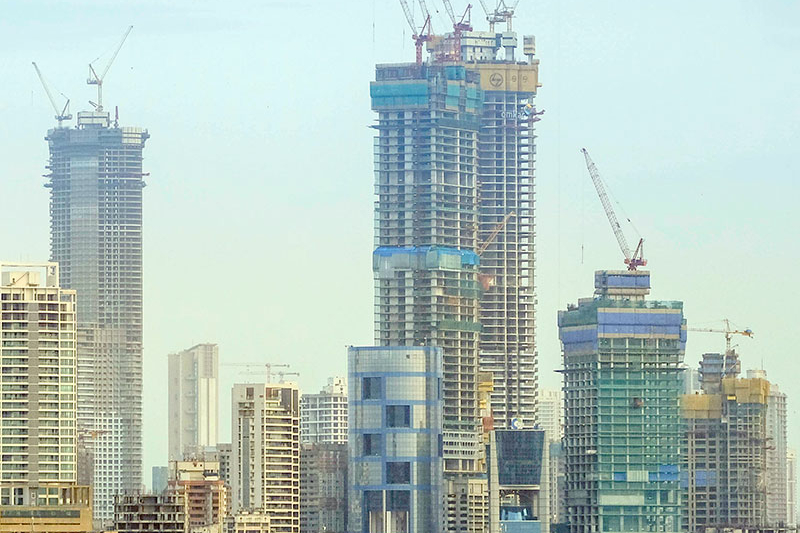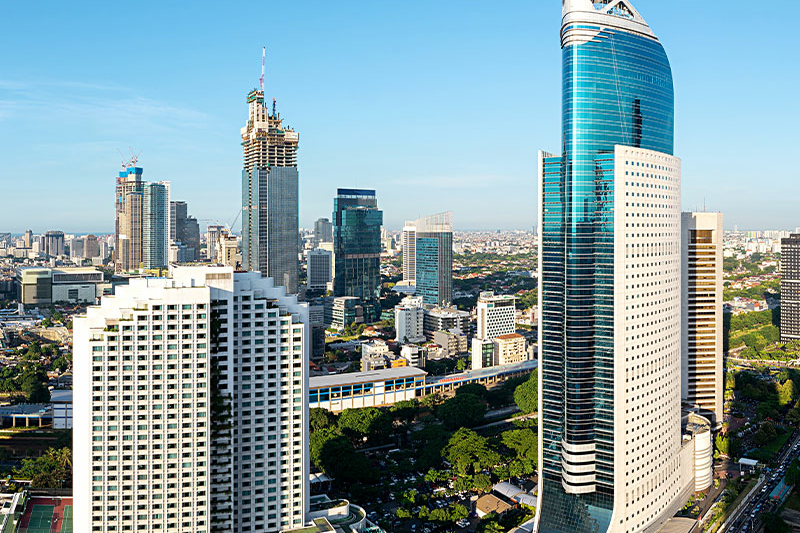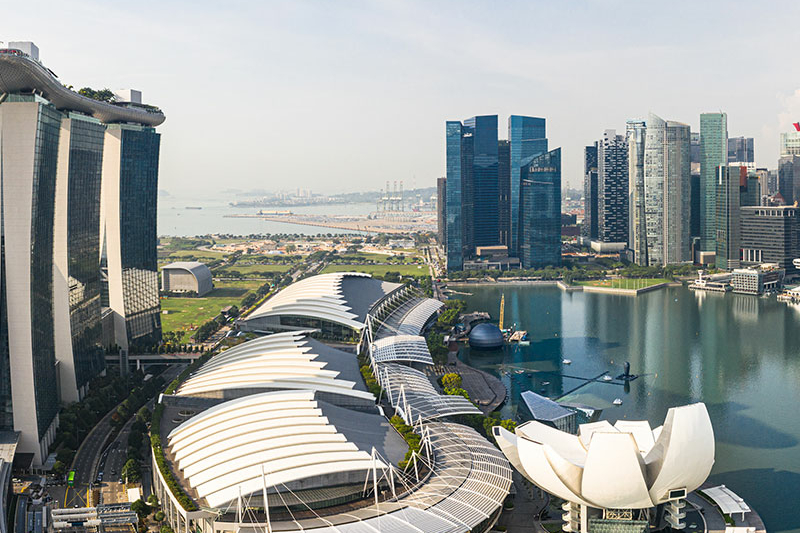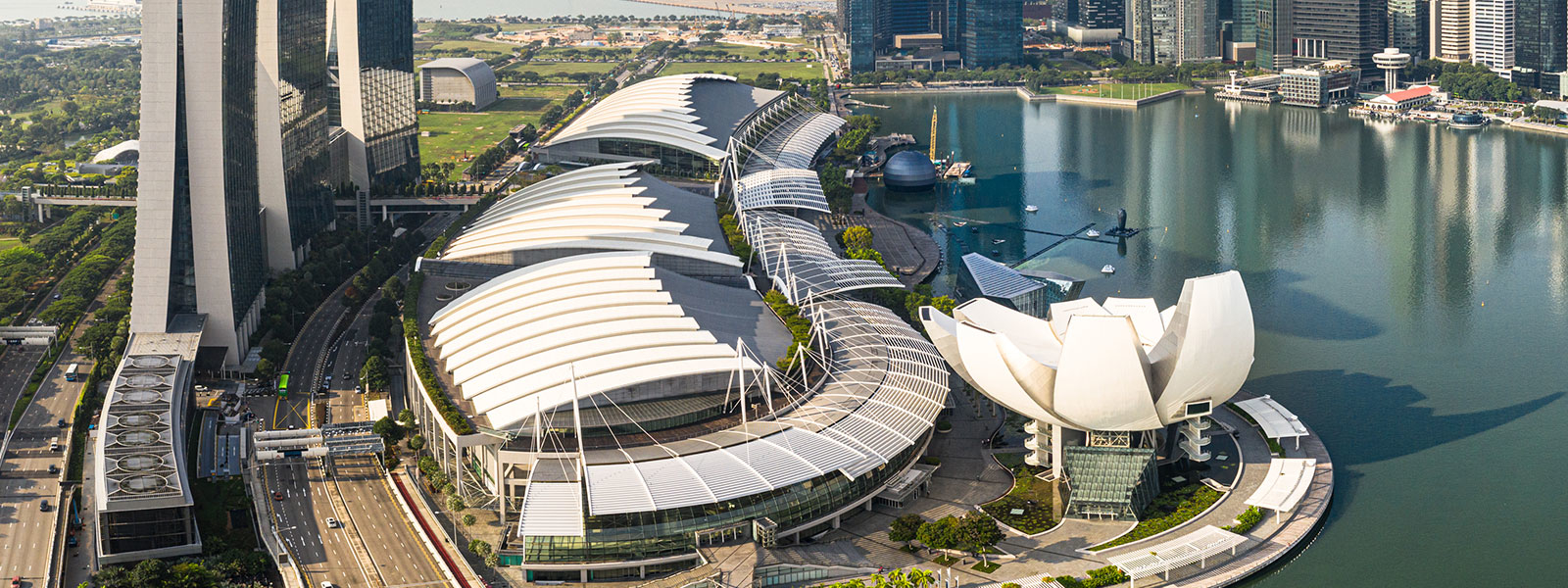Australia
Australia is a highly advanced mixed economy, but investors – often drawn to the country's economic stability and resilience – should be aware of certain clauses that typically appear in construction contracts.

The construction sector in Asia-Pacific is set for considerable growth, although that comes with challenges. In any largescale construction project, myriad risks exist to cause disruptions and delays, but there are best practices for mitigating these risks and resolving disputes.
The International construction industry, sensitive though it is to global economic cycles, has proven itself remarkably resilient in the face of the pandemic. In much of the developing world, including countries in the Asia-Pacific region, it also holds the key to economic recovery due to its potential for job creation. Coupled with a drive toward sustainability and digital transformation, the sector is set for considerable growth in the next few years. Some market observers suggest that the construction industry in Asia-Pacific might reach US$312.67 billion by 2024.
Governments across Asia-Pacific are looking to infrastructure to help stimulate growth as the region begins to return to some form of normalcy post-COVID-19. Encouraged by this government focus, investors are turning to view Asia-Pacific as a land of opportunity. But with rapid growth comes challenges. Construction projects around the world rely heavily on long supply chains: equipment, material and labor. A disruption to any link in that chain can result in delay and increased costs, and the way parties approach risk allocation and mitigation can have significant financial implications.
As construction projects around the world were interrupted or suspended against the backdrop of the pandemic, project owners, developers and contractors have started to look at their contractual terms more closely. Force majeure is not the only option for obtaining relief, often other—and more appropriate—avenues exist that merit exploring at an early stage. Savvy market participants will proceed with great caution and will take steps to mitigate risk, avoid disputes and ensure the best possible outcome through settlement or arbitration should disputes arise.
Australia is a highly advanced mixed economy, but investors – often drawn to the country's economic stability and resilience – should be aware of certain clauses that typically appear in construction contracts.

In recent years, the construction industry in India has emerged as an attractive destination for foreign investment. To support this heightened interest, the government of India has enacted an attractive foreign direct investment policy.

The construction industry in Indonesia has long been considered the backbone of the country's economic and social development, and regulations are being continuously amended to ease complexity and expedite processes for businesses and foreign investors.

With its strategic location and significant natural resources, Malaysia is an internationally recognized investment-friendly jurisdiction with a significant construction industry. Malaysian law offers procedural safeguards and mechanisms for dispute resolution to facilitate, for example, regular and timely payment under construction contracts.

The Philippines construction industry is expected to grow with the introduction of the "Build, Build, Build" initiative and the amendment of a number of laws that would loosen restrictions on foreign investment.

With a significant and coherent body of case law on construction disputes, Singapore is a hub for resolving many construction disputes across the Asia-Pacific region.

Changes in the construction law and favorable government policy continue to spur Vietnam's construction industry.


With a significant and coherent body of case law on construction disputes, Singapore is a hub for resolving many construction disputes across the Asia-Pacific region.
April 1, 2015
The SOP Act broadly applies to contracts for construction work entered on or after April 1, 2015
Singapore is a vibrant country in Southeast Asia. With its excellent location, it is a hub for resolving many construction disputes across the Asia-Pacific region. This has allowed Singapore to develop a significant and coherent body of case law on construction disputes. Singapore has also been active in passing legislation (e.g., the Building and Construction Industry Security Payment Act) and promoting dispute resolution mechanisms (e.g., the Singapore Infrastructure Dispute-Management Protocol) which are specifically tailored toward the construction industry.
Singapore is a common law country, with its laws primarily based on English law.
In comparison to other countries in the region, Singapore has limited restrictions on foreign investment. There are some sectors where foreign investment controls are imposed, for instance in real estate, media broadcasting and national security. Generally, the approach is one of consultation between regulators and foreign investors. Singapore has an investor-friendly tax regime.
Under Singapore law, a breach of contract does not automatically allow a party to terminate the contract
Generally, Singapore law recognizes and upholds freedom of contract. It is the exception, rather than the norm, that a clause might be deemed unenforceable. Nevertheless, in a few situations, key clauses of a construction contract may be unenforceable under Singapore law. Two types of clauses are of particular interest:
Liquidated damages are ascertained damages that the parties agreed to be payable should the contract be breached.
A liquidated damages clause is enforceable in Singapore, as long as it represents a genuine pre-estimate of loss. Otherwise, it will be treated as a penalty and not be enforced.
Whether a clause is a liquidated damages clause or a penalty is a matter of construction. It is determined in light of the facts and circumstances when the contract was signed. As set out recently by the highest court in Singapore (the Court of Appeal), the key test is whether the stipulated sum is "extravagant and unconscionable" in amount in comparison with the greatest loss that could conceivably be proved to have followed from the breach.5 The position in Singapore differs from that in the United Kingdom where the question is whether the clause imposes a detriment that is out of proportion to any "legitimate interest of the innocent party."6 The Singapore Court of Appeal had noted the considerable uncertainty over what constitutes a "legitimate interest," and declined to adopt the UK approach.
Exclusion or exemption of liability clauses seek to completely exclude a contracting party's liability. Limitation of liability clauses seek to limit contractual liability.
Whether an exclusion or limitation of liability clause will have its intended effect depends on three main elements: incorporation; construction; and regulation.
For the clause to be effective, it has to be incorporated into the contract. This could be done by signing the contract,7 bringing the clause to the other party's attention before or at the time the contract is made,8 or on the basis of the parties' prior course of dealing.9
The clause has to clearly set out the situations under which a party's liability would be excluded. Any ambiguity will be resolved against the party seeking to rely upon the clause.10 For example, to exclude liability for negligence, it would be preferable to expressly refer to the word "negligence" in the clause.11
Singapore adopts a less strict approach for limitation of liability clauses as compared to exclusion clauses. This is because Singapore law recognizes that these clauses are part of the overall risk and remuneration allocation between the parties, and that it is possible for the other party to insure.12
An exemption of liability clause might also be subject to certain statutory restrictions. The Unfair Contract Terms Act (UCTA) imposes two key restrictions on commercial contracts.13 First, any exclusion or limitation of liability for negligence must satisfy the requirement of "reasonableness," as defined in the statute.14 Second, where a party deals on the other's written standard terms of business, any exclusion or limitation of liability (whether for negligence or otherwise) must also satisfy the reasonableness test.15
Depending on the location of the parties/transaction, these restrictions might not apply (e.g., they generally do not apply to international sale of goods contracts, or where the governing law of the contract would have been the law of some country other than Singapore, but for the parties' choice of Singapore law).16
An innocent party may terminate the contract when the contract clearly and unambiguously provides for events under which it could terminate the contract
The Building and Construction Industry Security Payment Act (SOP Act) broadly applies to contracts for construction work or related goods or services, to the extent it deals with construction work carried out in Singapore.17 It applies to contracts entered on or after April 1, 2005. It aims to improve cash flow in the construction industry by giving parties the right to seek progress payments for work done, and providing fast and low-cost adjudication for payment disputes.
The SOP Act provides, among other things, a right to progress payments. This means that under certain circumstances, a contractor can claim payments for the carrying out of construction work, or the supply of related goods or services, under a construction contract. The claims process is relatively straightforward. A contractor first serves a "payment claim" on a respondent, who must then serve a "payment response." Where payment is disputed (or the respondent otherwise fails to pay), the contractor may apply to an authorized nominating body, which appoints an adjudicator. The respondent may reply to the application, after which the adjudicator will make a determination. The process typically takes a matter of weeks.
The adjudication decision is binding on the parties unless or until any dispute between them is resolved by agreement or determined by a court or arbitral tribunal.
Under the SOP Act, a contractor may suspend works upon failure of the respondent to pay an adjudicated amount (upon giving notice).18 The contractor may also exercise a lien on goods supplied by the contractor to the respondent.19
Separately, the SOP Act makes pay-when-paid clauses unenforceable. Under a pay-when-paid clause, a party (e.g., a sub-contractor) is paid only when the other contracting party (e.g., the main contractor) has received payment from some third party (e.g., the employer). Parties should consider how this affects the risk allocation among themselves.
SGD 500
million
The SIDP is designed and recommended for construction of infrastructure projects of more than SGD 500 million in value
The starting point is that a breach of contract does not automatically allow a party to terminate the contract.
An innocent party may terminate the contract where the contract clearly and unambiguously provides for events under which it could terminate the contract, and those events have occurred.
If the contract does not provide such a right, the innocent party may terminate the contract in broadly three situations:
a. Repudiation: Repudiation occurs when a party refuses to perform the contract (i.e., it renounces the contract). Examples of repudiation by the employer in construction disputes include: the employer's failure to give possession of the site to the contractor; when the contractor is wrongfully ejected from the site; or when the architect or contract administrator refuses to certify payment at the appropriate time or constantly under-certifies the amount due because of undue influence from the employer.20
b. Breach of a condition: A condition is defined as a term that the parties have agreed to be so important that its breach would entitle the innocent party to treat the contract as discharged.21 The focus here is on the nature of the term breached, and not the consequences of the breach.
c. Fundamental breach: Even if the clause that was breached is not a condition, the innocent party may terminate the contract if the breach was "fundamental."22 A fundamental breach "deprives the innocent party of substantially the whole benefit that it was intended to obtain from the contract".23 For example, a fundamental breach may occur when defects to a building are so serious that the entire building has to be rebuilt.24
Singapore has been at the forefront of developing alternative dispute resolution procedures, including mediation and dispute board determination
Under Singapore law, the parties are free to agree to contractual provisions dealing with unforeseen circumstances. For example, the parties can agree to a hardship or force majeure clause. A force majeure clause is an agreement on how outstanding obligations should be resolved when affected by unforeseeable events.25 It contractually allocates the risks between the contracting parties with regard to those events, which would be specified in the clause.26
Even if the parties have not provided for it, a contract can be discharged by frustration. This is when, without the default of either party, a contractual obligation has become incapable of being performed because performance in the circumstances would be radically different from what was undertaken in the contract.27
Frustration can happen in situations when the subject matter of the contract has been destroyed, the contractual promisor has died or become physically incapacitated, and when the source of supply of the contract has failed.28 The doctrine of frustration is only applied in exceptional circumstances.29
When a contract is frustrated under common law, it is automatically discharged.30 Parties can exclude the doctrine of frustration by doing so clearly and unambiguously in the contract.31
A Singapore court may allow a party to recover payments made or expenses incurred before the frustrating event occurred, depending on the circumstances of the case and whether it is just to allow such recovery.32
Because of their nature and function, both frustration and force majeure could be relevant when there is a radical external event that occurs during the course of the contract's performance, which was not due to the fault of any of the contracting parties.33 Whether either applies would depend heavily on the circumstances of the case and, for force majeure, the precise wording of the force majeure clause.
The two most common methods of dispute resolution in Singapore are litigation and arbitration:
Singapore has also been at the forefront of developing alternative dispute resolution procedures, including mediation and dispute board determination:
The Dispute Board will meet the parties to establish a schedule of Dispute Board meetings and site visits.34 At any stage of the project, the parties themselves or the Dispute Board may raise a difference between the parties that must be resolved. In such circumstances, the Dispute Board may discuss with senior representatives of the parties and provide assistance to enable the parties to proceed or continue with their negotiations.35 Parties may also apply to the Dispute Board for an opinion36 or determination.37
The SIDP is designed and recommended for construction or infrastructure projects worth more than SGD 500 million. This may be due to the potentially high expenses of engaging a Dispute Board from the start of the project.
1 World Bank, https://data.worldbank.org/indicator/SP.POP.TOTL?locations=SG.
2 World Bank, https://data.worldbank.org/indicator/NY.GDP.MKTP.CD?locations=SG.
3 Singapore Department of Statistics, https://www.singstat.gov.sg/modules/infographics/economy.
4 Building and Construction Authority of Singapore, Media Release, https://www1.bca. gov.sg/docs/default-source/docs-corp-news-and-publications/media-releases/singapore-construction-demand-2020-mr08012020.pdf, para. 5.
5 Denka Advantech Pte Ltd and another v Seraya Energy Pte Ltd and another and other appeals [2020] SGCA 119, at paras. 66 and 254 (affirming the test set out in the English case of Dunlop Pneumatic Tyre Co Ltd v New Garage and Motor Co Ltd [1915] AC 79).
6 Cavendish Square Holding BV v Makdessi [2016] AC 1172.
7 Consmat Singapore (Pte) Ltd v Bank of America National Trust & Savings Association [1992] 2 SLR(R) 195, at para. 29.
8 Thornton v Shoe Lane Parking Ltd [1971] 2 QB 153 (referred to in Tjjoa Elis v United Overseas Bank [2003] 1 SLR (R) 747, para. 75).
9 Zicom Pte Ltd v Antara Koh Pte Ltd [1997] SGHC 215, at paras. 5-7.
10 This is known as the contra proferentem rule.
11 Rapiscan Asia Pte Ltd v Global Container Freight Pte Ltd [2002] 1 SLR(R) 701, at paras. 44-45. The starting point is that parties to a contract do not normally agree to accept the consequences of each other's negligence, unless the contract does not allow any other reasonable construction.
12 Rapiscan Asia Pte Ltd v Global Container Freight Pte Ltd [2002] 1 SLR(R) 701, at para. 61.
13 There are other restrictions in the Unfair Contracts Terms Act (UCTA), but we only note those which typically arise in the context of commercial, business-to-business contracts.
14 Unfair Contracts Terms Act (Cap 396, 1994 Rev Ed), section 2(2). The test for reasonableness is set out in section 11.
15 Unfair Contracts Terms Act (Cap 396, 1994 Rev Ed), section 3.
16 Unfair Contracts Terms Act (Cap 396, 1994 Rev Ed), sections 26 and 27.]
17 This is regardless of whether the parties chose Singapore law as the governing law. Building and Construction Industry Security of Payment Act (SOP Act), section 4.
18 SOP Act, sections 23 and 26.
19 SOP Act, sections 23 and 25.
20 See Halsbury's Laws of Singapore, Building and Construction (2010 issue), para. 30.203.
21 RDC Concrete Pte Ltd v Sato Kogyo (S) Pte Ltd [2007] 4 SLR 413, at para. 97.
22 Sports Connection Pte Ltd v Deuter Sports GmbH [2009] SGCA 22, at para. 74.
23 Sports Connection Pte Ltd v Deuter Sports GmbH [2009] SGCA 22, at paras. 75-76.
24 See e.g., the Malaysian decision of Hwa Chea Lin v Malim Jaya (Melaka) Sdn Bhd [1996] 4 MLJ 544 (court finding a fundamental breach where 'the said building when delivered to the plaintiffs was in a terrible shape that required massive remedial works and eventually had to be rebuilt'), which may be regarded in Singapore as persuasive.
25 RDC Concrete Pte Ltd v Sato Kogyo (S) Pte [2007] SGCA 39, at para. 56.
26 RDC Concrete Pte Ltd v Sato Kogyo (S) Pte [2007] SGCA 39, at para. 53.
27 Alliance Concrete Singapore Pte Ltd v Sato Kogyo (S) Pte Ltd [2014] SGCA 35, at paras. 34-36; RDC Concrete Pte Ltd v Sato Kogyo (S) Pte [2007] SGCA 39, at para. 59 (citing Davis Contractors Ltd v Fareham Urban District Council [1956] AC 696).
28 Alliance Concrete Singapore Pte Ltd v Sato Kogyo (S) Pte Ltd [2014] SGCA 35, at para. 55; Andrew Phang Boon Leng, The Law of Contract in Singapore (2012), para. 19.027; Taylor v Caldwell (1863), 122 ER 309.
29 Alliance Concrete Singapore Pte Ltd v Sato Kogyo (S) Pte Ltd [2014] SGCA 35, at para. 38.
30 RDC Concrete Pte Ltd v Sato Kogyo (S) Pte [2007] SGCA 39, at para. 61.
31 RDC Concrete Pte Ltd v Sato Kogyo (S) Pte [2007] SGCA 39, at para. 63.
32 Frustrated Contracts Act (Cap 115, Rev Ed 2014), section 2..
33 RDC Concrete Pte Ltd v Sato Kogyo (S) Pte [2007] SGCA 39, at para. 57.
34 Singapore Infrastructure Dispute-Management Protocol, Clause 4.1.
35 Singapore Infrastructure Dispute-Management Protocol, Clause 5.
36 Singapore Infrastructure Dispute-Management Protocol, Clause 8. An Opinion is not binding on the parties (if any party objects to the opinion). If there is no objection, the Opinion must be complied with unless it is successfully challenged in litigation or arbitration.
37 Singapore Infrastructure Dispute-Management Protocol, Clause 9. A Determination is binding on both parties, unless it is successfully challenged in litigation or arbitration.
White & Case means the international legal practice comprising White & Case LLP, a New York State registered limited liability partnership, White & Case LLP, a limited liability partnership incorporated under English law and all other affiliated partnerships, companies and entities.
This article is prepared for the general information of interested persons. It is not, and does not attempt to be, comprehensive in nature. Due to the general nature of its content, it should not be regarded as legal advice.
© 2021 White & Case LLP